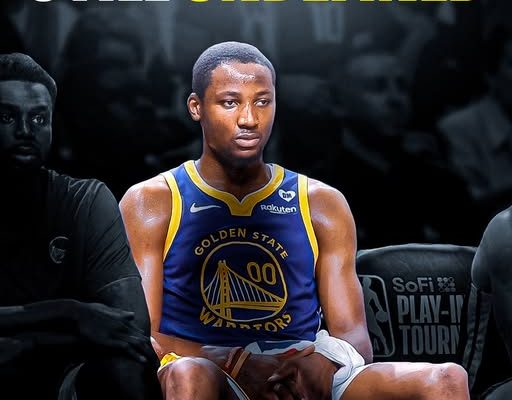Jonathan Kuminga entered the NBA with all the fanfare and promise of a future star. Selected seventh overall in the 2021 NBA Draft by the Golden State Warriors, Kuminga was seen as a dynamic athlete with rare upside—a blend of explosive physical tools, versatility, and raw talent that could one day blossom into a cornerstone player for the franchise. Four seasons into his professional career, however, Kuminga’s true game remains elusive, and the league has yet to fully witness the player he was expected to become. This gap between potential and production is magnified within the Warriors’ veteran-first approach, which prioritizes established stars and immediate success over developmental patience, making Kuminga’s path to stardom even more complicated.
From the outset, Kuminga’s skill set intrigued scouts and analysts alike. At 6-foot-8 with a 7-foot wingspan, his physical profile screams versatility. He boasts exceptional athleticism, the ability to guard multiple positions, and flashes of offensive creativity that hint at a high ceiling. Early hype painted him as a future elite wing, capable of scoring in isolation, finishing at the rim, and defending with intensity. This raw talent was precisely what the Warriors wanted to add to their roster as they sought to rejuvenate a team that had captured multiple championships but was facing the inevitable physical decline of its core stars.
Yet, the transition from potential to performance has been uneven. Kuminga’s four seasons have been marked by spurts of brilliance mixed with stretches of inconsistency. His highlight-reel dunks and defensive rotations have turned heads, but the finer points of his game—consistent shooting, decision-making, and offensive polish—have lagged behind expectations. His shooting mechanics remain a work in progress, leading to subpar shooting percentages from both three-point range and midrange. This inefficiency limits the Warriors’ ability to utilize his skills fully in their offense, which historically relies on precision shooting and ball movement.
A key factor in Kuminga’s slow development is the context of his environment. The Golden State Warriors, under head coach Steve Kerr, have consistently operated with a veteran-first philosophy. This approach, while effective in maintaining a championship culture, often means that younger players like Kuminga are tasked with learning behind seasoned stars such as Stephen Curry, Klay Thompson, and Draymond Green. These veterans not only command the majority of the offensive touches but also set the tone defensively and in terms of leadership. This structure, while beneficial for winning now, can inadvertently stifle the growth of promising youngsters who need more freedom and minutes to explore and expand their games.
Kuminga’s minutes per game have fluctuated over the years, reflecting both his developmental stage and the Warriors’ need to maximize the performance of their veteran core. While he has shown glimpses of effective defense and energy plays off the bench, he has yet to carve out a consistent role that allows him to build confidence and rhythm. This role ambiguity can be detrimental to young players trying to establish themselves in the league. Without a defined niche or clear expectations, Kuminga faces the challenge of proving his worth in limited spurts, making it difficult to demonstrate sustained improvement.
Moreover, Kuminga’s playing style requires refinement to fit within the Warriors’ system. Golden State’s offense is predicated on spacing, ball movement, and shooting efficiency—elements that demand high basketball IQ and precision. Kuminga’s raw athleticism and strength are undeniable assets, but his offensive game still lacks the nuanced skill set needed to consistently contribute in a system designed around elite shooters and playmakers. His handle is still developing, his shot selection inconsistent, and his playmaking skills in need of expansion. These limitations have kept him on the periphery rather than at the core of the Warriors’ rotation.
Another dimension to consider is Kuminga’s mental approach and maturity on the court. The NBA is not only a physical challenge but a mental and emotional one. Young players often struggle with confidence, decision-making under pressure, and adapting to the pace and complexity of the professional game. Kuminga’s journey has been no exception. There have been moments where hesitation or forced plays have disrupted the flow of the offense or led to turnovers. For a player with his size and athleticism, building confidence and basketball IQ are essential steps toward becoming a reliable contributor. These aspects often require time, mentorship, and consistent opportunities—elements that are somewhat constrained in a veteran-centric environment.
Comparisons to other young players in the league underscore Kuminga’s predicament. Many young stars who have flourished early were placed in roles where they could shoulder significant responsibility and develop through trial and error. Players like Anthony Edwards, Jayson Tatum, and Devin Booker were given the green light early to showcase their scoring prowess and develop their games organically. In contrast, Kuminga’s role with the Warriors is more specialized and limited, emphasizing defense and energy plays while his offensive game remains secondary. While this approach nurtures team success, it can delay the emergence of a player’s full offensive arsenal.
Injuries have also played a part in Kuminga’s uneven progression. Like many young athletes, Kuminga has dealt with minor setbacks that interrupted his rhythm and development. While not severe enough to sideline him for extended periods, these interruptions can break the continuity young players need to develop confidence and consistency. Missing key developmental minutes can be costly when competing for playing time on a roster stacked with established stars and role players.
Despite these challenges, there is ample reason to remain optimistic about Kuminga’s future. The Warriors have demonstrated patience and commitment to his growth, providing him with opportunities to contribute in critical moments during playoff runs and regular-season contests. His defensive versatility makes him a valuable asset in an era that prizes switchability and multi-positional defenders. If he can refine his shooting and playmaking, Kuminga could become a cornerstone for the Warriors’ next era once the current veterans move on or retire.
The Warriors’ veteran-first approach is both a blessing and a curse for Kuminga. On one hand, it offers him the chance to learn from some of the greatest players in recent NBA history, gaining insights into leadership, preparation, and championship mentality. On the other, it limits his opportunities to take risks and develop his offensive game fully. Balancing immediate team success with long-term player development is a perennial challenge for organizations, and Golden State exemplifies this struggle in Kuminga’s case.
For Kuminga to finally unlock his full potential, several factors must align. Increased minutes with clear offensive responsibilities would allow him to find his rhythm and build confidence. A tailored development plan focusing on shooting mechanics, decision-making, and ball handling could elevate his offensive impact. Mentorship from veterans remains invaluable, but coaching staff must also be willing to let Kuminga take on more responsibility and learn through experience. Patience from fans and analysts is critical as well, recognizing that developing a multi-dimensional NBA star is rarely a linear process.
, Jonathan Kuminga’s journey through his first four NBA seasons reflects the complex interplay between raw talent, developmental environment, and team philosophy. While his true game still eludes full realization, the foundation is unmistakably present. His blend of physical tools and defensive potential sets him apart, but translating that into a consistent, impactful offensive game within the Warriors’ veteran-first framework remains a work in progress. If Kuminga and the organization can navigate these challenges, the young forward has the potential to emerge as a vital piece of Golden State’s future—one that complements the legacy of the current dynasty while ushering in a new era of excellence. Until then, Kuminga’s career will continue to be watched with cautious optimism, a reminder that untapped potential is only as valuable as the opportunity to unlock it.



